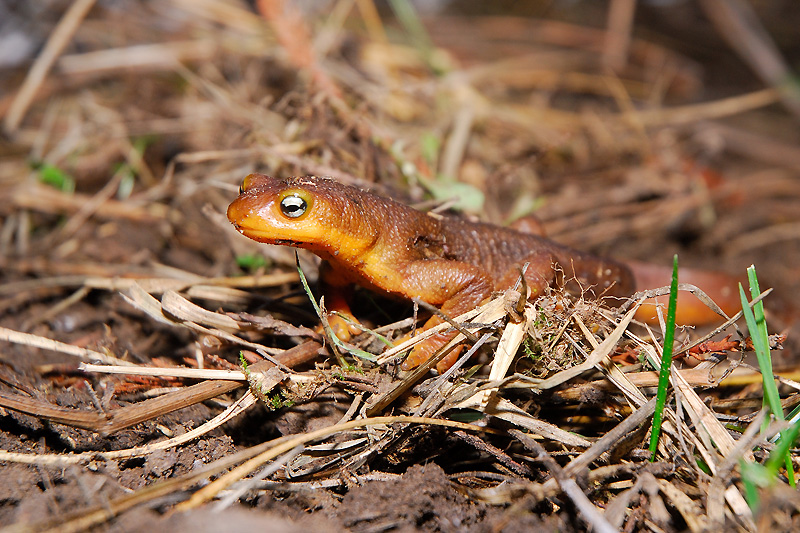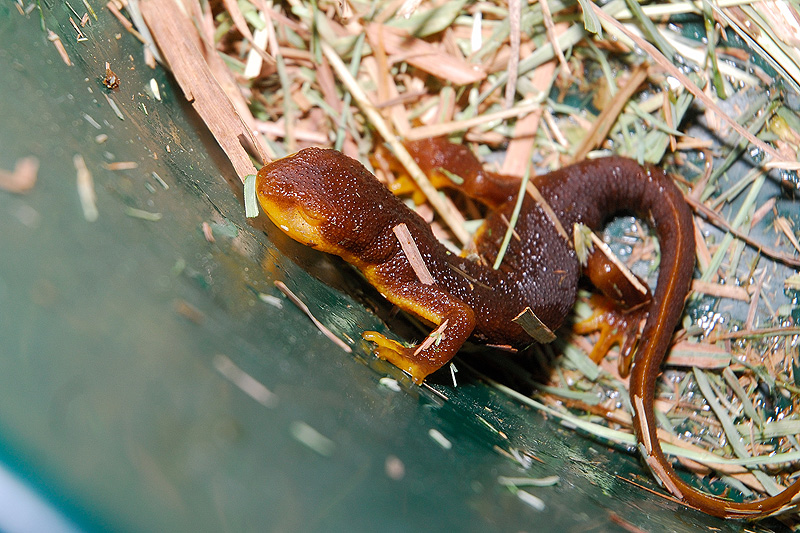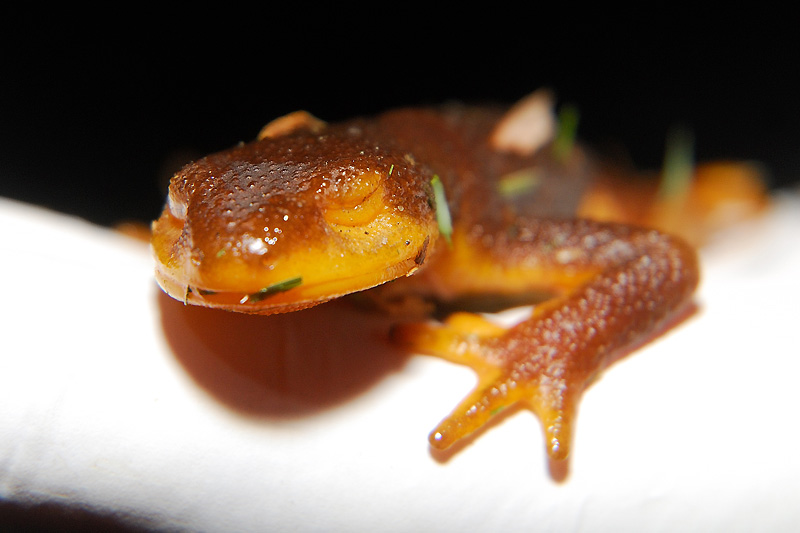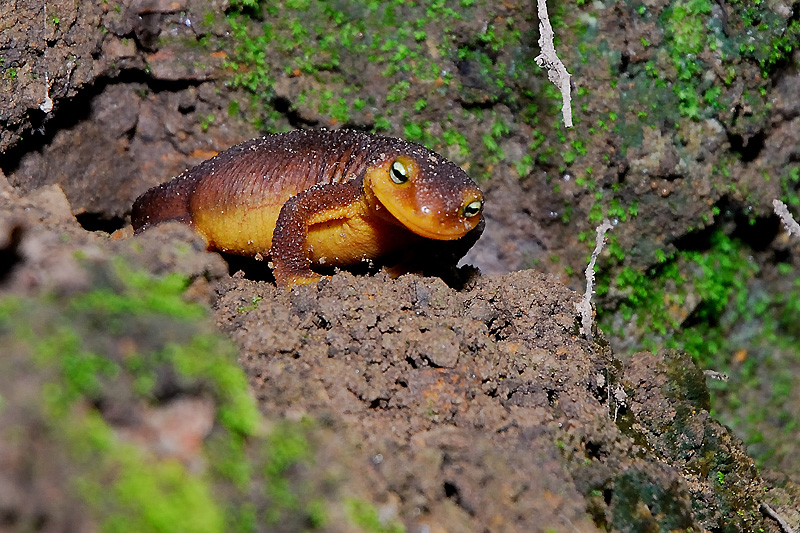It’s no secret that California is now rushing headlong into its third year of drought. Hills and fields that should be emerald green at this time of year are still end-of-summer brown. Headlines are filled with stories about water districts implementing mandatory conservation measures, reservoirs and lakes are critically low, wells are running dry, fields are being left fallow, and established orchards left to wither and die.
There are many things we can do as humans to control how much water we use, or waste, over the coming months, knowing that we are unlikely to receive enough rainfall in the next few weeks to prevent our drought from worsening.


Although we can’t control the weather, we do have some degree of control over how we choose to weather this drought.
However, recently my attention was turned toward those that have absolutely no control over the resources, or lack thereof, in their environment, and will be directly impacted by our own conservation efforts. While walking to the barn one evening last week I came across this Coast Range Newt (Taricha torosa torosa).
This alone was hardly newsworthy, as we frequently see them on the farm, or at least we do during our normally wet winters. I then realized that it was already the end of January, and this was the first newt I’d seen this entire fall and winter season, probably because it’s been so dry.
November through February is the normal breeding season for this species, which coincides with our wettest months of the year. However, the rain has been conspicuously absent this winter, and our creek beds are still dry. As is typical of amphibians, this species is dependent on an aquatic environment for reproduction.
That caused me to wonder how severely our native amphibian populations on the farm may be impacted in the midst of this record-smashing drought, especially with no water in our creeks.
We’ve observed at least six different species of amphibians on the farm over the years. The Coast Range Newt (Taricha torosa torosa), California Slender Salamander (Batrachoseps attenuatus), Arboreal Salamander (Aneides lugubris), Yellow-eyed Ensatina (Ensatina eschscholtzii xanthoptica), Sierran Treefrog (Pseudacris sierra), and the California Giant Salamander.
I’ve always taken pride in the fact that with two creeks flanking the property, that our amphibian populations here on the farm appear to be robust, and healthy. We don’t use pesticides, herbicides, or synthetic fertilizers on the farm, we mitigate erosion and runoff, so I like to think that the native amphibians that call the farm home have a relatively clean environment in which to live, forage, and reproduce.
This last weekend though, I wondered if our environment here is really as clean as I’d like to think. Amphibian species are renowned for being particularly sensitive to environmental stressors, and in the last two decades numerous papers have been written about a wide variety of deformities in amphibian species, and their potential causes.


This weekend I observed my first amphibian on the farm with an obvious deformity, after I almost stepped on it. I found this newt on the steps leading up to the buck pen, and as I bent down to scoot it away to safety, I immediately saw that something was clearly NOT normal.
Look closely at both of these pictures. What’s missing?
No, this newt is not sleeping, in fact this individual is bilaterally anophthalmic. In other words, this newt is missing not one, but BOTH of its eyes. Needless to say I was surprised.
The eye lids appear to be normally developed, but the globes are clearly missing from the orbits. It’s a little difficult to tell in a two-dimensional image, but if you look at the profile of the orbits head on, you can see there are sunken depressions under the eyelids where the globes should be.
Based on body length, this particular individual appears to be a young adult. This species is believed to be reproductively mature at approximately three years of age. I freely admit that I’m not an expert at aging amphibians, but I would estimate this individual to be at least two-to-three years of age.
Despite being blind this individual has clearly adapted to its disability. It survived its aquatic life stage, matured through the juvenile stage, and has survived at least into young adulthood. This requires sourcing enough food, as well as avoiding predation, despite lack of vision. This species is estimated to have a lifespan of approximately 20 years, and although this individual may have a shortened lifespan as a result of this condition, so far this newt seems to be coping well despite being functionally blind. One still has to question though, why, or how, did this happen?


Of course the first thing that may come to mind is pesticide contamination. Fingers are often pointed immediately at pesticides in regards to amphibian malformations, and although amphibians are sensitive to toxins in their environment, pesticides aren’t the only cause of malformations in amphibians.
We don’t use pesticides or herbicides here on the farm, but admittedly we have no control over what our neighbors do on their own properties. We are aware of one immediate neighbor that still appears to be a slave to herbicides, because we caught him spraying brush on our property last year that we feed our goats.
He promptly was given a lesson in the consequences of trespassing, and educated about the blatant unnecessary use of herbicides. That likely fell on deaf ears however, as his response what that he’s “been doing this for 30 years”. I can only try to educate and inform, but I can’t fix entitlement, stubborn, or stupid, but hopefully something I said sunk in. I digress.
Fortunately, most of our other immediate neighbors do realize that it’s all of our responsibility not to contaminate our nearby waterways. However, with two creeks running through the property, contaminants can easily be transported here from upstream, and certainly exposure to certain toxins during critical stages of embryonic development could potentially have teratogenic effects.
Certainly, in the presence of such a severe drought over the last few years, one does wonder if pollutants in our local creeks, that in a normal year may not be of high enough levels to cause problems, could become relatively concentrated due to drought.

Decreased water flow, and evaporation, especially in the late spring months as rainfall declines, could potentially concentrate pollutants in the water. However, that said, there is no evidence that this case of bilateral anophthalmia in this newt was caused by toxins in the environment.
Spontaneous developmental errors can, and do, occur during development in all species. It is possible that this was simply a congenital defect. The answer to this newt’s missing eyes could be a simple case of genetics run amok. Up to 2% of cases of anopththalmia in amphibian populations is accepted as the background rate of incidence.[1,2,3]
Trauma also has to be considered as a potential cause for a missing eye. This trauma could occur during early stages of metamorphosis. Cannibalism by cohorts has been known to result in missing eyes in bullfrog tadpoles (pictures) raised in laboratory settings. As this is now our third year of drought, one might envision that in a shrinking body of water, during a drought, how populations of juveniles are all competing for dwindling resources. However, there do not appear to be overt signs of trauma, or scarring, in this individual, and it would seem less likely that both eyes would be missing from such a scenario, but the possibility still has to be considered. Note that the head shape appears normal otherwise, and both nares are present, and appear to be normally formed.

Some infectious organisms have been shown to result in amphibian developmental deformities as well. For example, in frogs a trematode parasite called Ribeiroia ondatrae has been implicated in limb deformities in frogs and toads in the western United States, especially in the Pacific Chorus Frog. However, this organism is thought to be less likely to cause ocular abnormalities such as this in amphibians. [4,5,6]
Another proposed cause of amphibian malformation is UV-B radiation, especially when exposed during critical developmental stages, although there’s some question as to the likelihood of this causing malformations in the field.
In the areas of the creek where I’ve observed juvenile newts in previous years on the farm, the riparian tree cover is quite extensive, so I suspect that UV-B radiation in this case would be far less likely as a cause of malformation, and UV-B radiation in laboratory settings is typically associated with asymmetric hind limb deformities. [7]
The truth is we’re unlikely to ever know why this particular individual lost both of its eyes. At this point it does give one pause to consider the possibilities, but in the years we’ve been at this location, and considering the number of amphibians we’ve seen on the farm during that time, for now we have to expect that this may simply have been a random genetic error. However, it will make me scrutinize other amphibians I encounter on the farm in the future. If others present with similar deformities, then that might be more suggestive of an environmental cause, and would certainly warrant further investigation.
This particular newt was moved to an area off the path, out of harms way, and this weekend we observed a number of healthy newts that are starting to emerge after we received almost half-an-inch of rain! The drought is far from over though.
There is more rain in the near-term forecast, but it’s unlikely we’ll recover much of our water deficit this season, as our rainy season is almost over. In the meantime, please remember that when you forget to turn off the water while brushing your teeth, or insist on irrigating your lawn unnecessarily, that your day-to-day choices affect much more than whether or not neighborhood lawns will be green, or brown, this season.

This individual was immediately released to a safer location a few feet from where it was found. We leave all wild animal species at Curbstone Valley in their natural environments, and are careful not to damage sensitive habitat and hiding places. Note that it is illegal to collect and possess native reptile or amphibian species in California without the required licenses and/or permits.
———————
[1] Amphibian Abnormalities on National Wildlife Refuges. Nov 2013. US Fish and Wildlife Service. Online publication.
[2] Environmental Quality: Amphibian Declines and Deformities. US Fish and Wildlife Service Online resource, retrieved February 2014.
[3] Environmental Quality: Abnormal Amphibian Monitoring. US Fish and Wildlife Service Online resource, retrieved February 2014.
[4] Kiesecker, J.M. 2002. Synergism between trematode infection and pesticide exposure: A link to amphibian limb deformities in nature? Proceedings of the National Academy of Sciences USA 99: 9900-9904
[5] Stopper, G.F., Hecker, L., Franssen, R.A. and S.K. Sessions. 2002. How trematodes cause limb deformities in amphibians. Journal of Experimental Zoology 294: 252-263.
[6] Gilliland, M.G. and P.M. Muzzall. 2002. Amphibians, trematodes, and deformities: an overview from southern Michigan. Comparative Parasitology 69: 81-85.
[7] Levey, R. 2003. Investigations into the Causes of Amphibian Malformations in the Lake Champlain Basin of New England. Vermont Department of Environmental Conservation.


What a beautiful amphibian! Glad to see it’s doing well even without the eyes, and you make a good point about pollutant concentrations during drought. (I’m eager to see what the Giant Salamander looks like, but I suspect I’ll be somewhat disappointed in its actual size.)
I’ve only ever seen one California Giant Salamander (Dicamptodon ensatus) in 7 years here. Unfortunately, I didn’t have my camera when I found it, although my neighbor did have a cell phone camera. I was surprised, and thrilled, to see it, as it has a very limited range in California, but sadly I haven’t seen one since. I promise though, if I do see one again, I WILL have my camera, and I will post! In the meantime, there’s a picture here from the California Herps website of one specimen that is almost a foot in length: http://www.californiaherps.com/salamanders/images/dicamprulestim.jpg
It’s no Godzilla, but in salamander terms it is quite large!
Good thing you found him, but as you say, he’s found a way to survive (and thrive!) to this point. It’s an interesting phenomenon, and I wonder what caused it. I hope you’ll get more rain before the dry season sets in.
It was pure dumb luck that I bumped into this fellow. Luckily for him, I was not a predator. Overall he/she is doing a remarkable job at going undetected. I honestly thought, as I left the buck pen, that I must’ve stepped on the poor thing on the way up. I didn’t see it on my way to feed the bucks, but I was very relieved to see it was unharmed on my way back to the house. I do think we’ll get a little more rain. Apparently our Pacific “ridiculously resilient ridge” has weakened somewhat. For this season I don’t expect it to be enough to make up for deficits, but anything at this point is most welcome!
Not likely that it is damage from a predator. Taricha species newts such as this coast range newt (aka California newt) contain a powerful neurotoxin and most animals know to avoid them although some gartersnakes have developed some resistance to the toxin (more on this at the great California Herps website link above). Because the skin is otherwise not deformed around the eye sockets and you don’t see any scars, I suspect this happened when the newt was an embryo or larvae. As soon as newt larvae hatch out of their eggs, they are carnivorous, so if this is a ‘birth defect’, that means this newt has been feeding itself without sight for its entire life which is amazing. Seems like it would be easier to do so while poking around in a muddy pond bottom than on land. Being a bit of a newt wonk, I see hundreds a year at many different places and of those, a handful will have a missing eye, extra toes or even an extra limb. I think as amphibians their embryos are somewhat more likely to develop odd cells and still survive into a hatchling, larvae and then adult. More about the early days of coast range newts Egg of Newt In any event, most newts around my location in the Santa Cruz Mountains are staying underground so far this year but perhaps this particular one can’t stock up enough food in its body and just had to come out to stumble upon food in its natal pond/stream which they can find even without eye sight- see http://www.nap.edu/readingroom.php?book=biomems&page=vtwitty.html
I mentioned tetrodotoxin in a previous Coast Range Newt post. Certainly makes them unpalatable to most predators!
I don’t think this newt’s anophthalmia occurred due to trauma either. Except for missing globes, this newt was seemingly otherwise perfect. I think a genetic error of some sort is most likely. In this case it simply appears as if the eyes didn’t develop at all. However, that said, I know in some frogs with seemingly missing eyes, they actually have ocular tissue in an aberrant location, that might not be readily visible from the surface. Regardless, like you said, if this was a genetic embryonic mishap, it really is remarkable that this individual has survived for so long!
I have seen a few Taricha sp. out and about here just in the last week or so, especially now we’ve had a little rain. Hopefully we’ll get a little more rain this weekend too, and that will encourage a few more out of hiding.
Poor little guy.
I’d feel more sorry for this newt, except he does seem to be remarkably well adapted, and appears to be coping very well. It’s quite likely he was never sighted, anophthalmia for him is his ‘normal’ 🙂
once found a frog in our Camps Bay garden, with only one eye. Beautifully patterned head, with the stripes on the blind side neatly completing the pattern. But after a few days he disappeared.
It’s my understanding that missing eyes in frogs is not uncommon. A couple of papers I read recently suggested that early trauma in the tadpole phase may be the primary cause. I’m just not sure how common missing eyes are in newts in comparison.
Clare, I just sent you an e-mail via your contact page. Check it out!
Thanks, Katie! Sent a message back 🙂
Clare thank you for the reminder. It is sad when we do not consider the consequences of our actions. Great post!